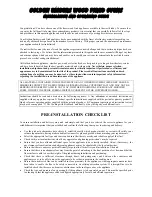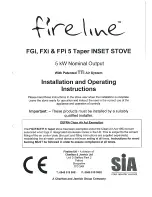
13
ENGLISH
Pellets and loading
Pellets are made by subjecting wood shavings i.e. the rejects of pure unpainted wood from sawmills, carpentry products and products from
other activities connected to wood working and transformation, to very high pressures.
This type of fuel is fully ecological as no glues are used for its compaction. In fact, pellet compactness is guaranteed over time by a natural
substance found in wood: lignin.
In addition to being an ecological fuel, making best use of wood residue, pellets also have a series of technical advantages.
While wood has a calorific value of 4.4 kWh/kg (with 15% moisture, therefore after approximately 18 months of curing), that of pellets is 5
kWh/kg.
Pellet density is about 650 kg/m
3
and water content is equal to 8% of its weight. For this reason pellets do not need to be cured to obtain a
sufficient heat yield.
tHe Use oF PooR QUalitY Pellets oR anY otHeR MateRial Will CoMPRoMise stoVe FUnCtions, Voiding
tHe WaRRantY and Releasing tHe ManUFaCtUReR oF liaBilitY.
Do not place the bag Directly on the stove to loaD the tank.
always use a scoop to loaD the tank. Do not rub or place weights on the tank seal. keep the tank cover
seal supporting surface clean at all times. check the conDitions of the seal frequently. if DamageD,
contact your local authoriseD technician.
The pellets used must be class
a1
certified according to standard
iso 17225-2
(
enplus-a1, din Plus
or
nF 444
of the following
category: “High quality NF biocombustible wood pellets”).
Uni en 303-5
with the following characteristics: water content
≤ 12%, ash content ≤ 0.5% and lower calorific value >17 MJ/kg (in
the case of boilers).
The Manufacturer recommends using pellets with a diameter of
6mm with its products.
Pellet stoRage
To guarantee combustion without problems, the pellets must be
kept in a dry place.
Open the tank lid and load the pellets using a scoop.
Pellet HoPPeR
During stove operation, the pellet hopper lid must always be closed.














































